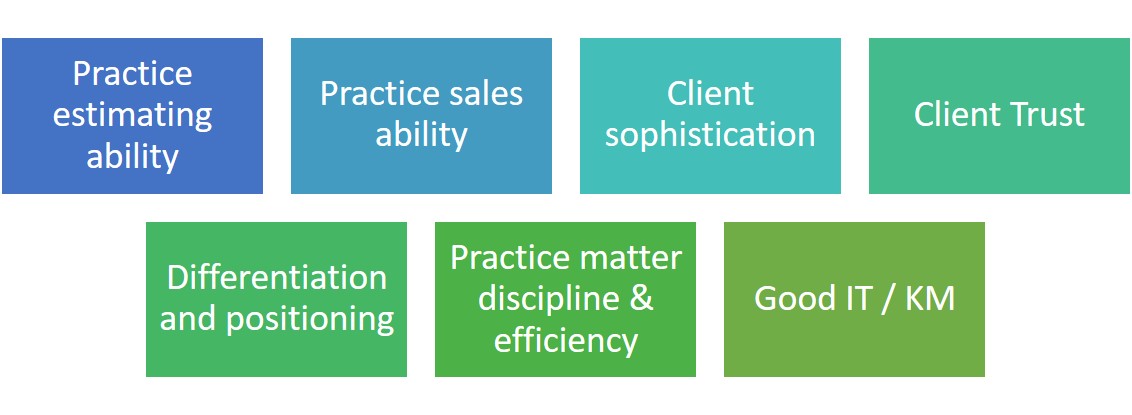
06 Jan Is your practice ready for value pricing?
Making the jump to value pricing (‘proper’ fixed fees) is a dramatic and important step for any practice. It can bring many benefits in terms of profitability, differentiation, client satisfaction and staff moraleBut are you doing it for the right reasons
And is your practice ready
Regrettably, some practices see a jump to fixed fees as a simple cure-all for various practice ills, whether this is under-charging, client pressure, low staff morale or poor productivity and time capture. I believe that practices should make the jump to fixed fees and value pricing from a position of strength rather than a position of weakness and have written before about how value pricing should not be seen as a remedy for poor time costing performance (See: Fixed fees and underpricing: seller beware)
So are you ready
Please see below the 7 issues I believe practices need to consider before jumping to value pricing. (When you actually jump, there`s more of course – this is just the prep stage! Next blog coming soon)
.
Value pricing: is your practice ready?
Practice estimating ability
Are you and your staff currently issuing confident, assertive estimates at the outset of the matter? Does recorded time or work-in-progress for the vast majority of matters come in at or below the original estimates you gave clients?
If not, you might be guilty of consistent underestimating – and then writing off time here there and everywhere. To understand why, see here: Low-balls and low-balling.
If your and your staff can’t issue assertive, realistic and profitable estimates now, what makes you think they are going to be able to confidently sell the value of (higher, more profitable) value prices? Take the discipline of time-costing away, and your staff might use that freedom to further indulge their insecurities and charge lower rather than higher prices. It happens, I’ve seen it!
I recommend ensuring good estimating performance BEFORE you make the jump to value pricing!
.
Practice sales ability
Can you sell? Can your team? When clients sign the costs agreement are they thinking `Yes, shut up and take my money, this is a great deal` or is it just some form of reluctant, resigned grudge purchase acceptance?
To be successful at value pricing, you and your team need to really communicate and sell the value of your services, rather than merely justify costs on the basis of time after the event. With value pricing, you are charging for value not time, so your success depends on your ability to communicate this value.
(Sell!)
.
Client sophistication
Value pricing works better with sophisticated clients. By this, I don`t mean the LPA definition, but more:
- clients who make discerning choices
- clients who appreciate superior quality (that’s you!)
- clients who understand the risks of working with inferior advisors
- clients who can understand the nature of the value pricing deal in terms of scope/pricing risks
- clients who have the confidence and ability to help shape the scope of work
.
Yes, good clients! If your clients look like the above, they are likely to both welcome value pricing and be easy to deal with. If your clients are less than sophisticated, there is a greater risk that they will question your value, will quibble over the bill and be difficult to deal with (pushing up your costs of production).
.
Client trust
Value pricing requires a higher element of client trust than time-costing. This is because you are asking clients to trust your estimates and assumptions over how much work is involved and what is therefore a fair price based on the likelihood or necessity of different tasks/actions.
Without trust, therefore, clients might prefer a time-costing approach instead of having to trust your assumptions.
Trust helps reduce price resistance because the presence of trust is a more important buying criteria than price itself. This is why more people choose their professional advisors on the basis of a referral than on price. Trust nearly always beats price (unless you are seen as offering a commodity, when trust isn`t so important).
The presence of trust is also part of the value that you are expecting your clients to pay more for. We are all happy to pay a little bit more for providers we trust. The presence of trust is value you can charge for.
Differentiation and positioning
Why should clients choose you over your competitors? Why should they pay a little bit more for you?
If you are pricing on value, you need to communicate (sell) the value of not only the desired end result, but also the differential value of working with you over another well-respected specialist practice (of which there are many).
This differentiation could include personal qualities, niches within niches, industry focus, service features – but the more persuasive your value propositions, the more pricing power you will have.
.
Practice matter discipline and efficiency
So, lets assume you've sold the value and issued a confident value price. The next stage is the matter discipline – completing the work according to scope and budget without indulging your inner perfectionist or doing extra work the client doesn`t value.
Yes, this could be a focus when you actually make the jump – implementing project management discipline and the like, but changing work habits takes time and I suggest your team need to demonstrate efficient personal behaviours before you make the jump.
.
Good information technology and knowledge management
When you move away from time costing, the more important efficiency becomes. Where time costing actually rewards inefficiency, value pricing will always reward efficiency.
And as with personal behaviours, this should be in place as much as possible before you make the jump to value pricing.
.
So are you ready?
.
To learn more:
- register for my online course Implementing value pricing at www.gileswatson.thinkific.com
- Contact me to discuss an in-house workshop to help your team prepare for and implement value pricing (0404 266174 / [email protected] / www.gileswatson.com.au)
- Look out for my public workshops this March




Sorry, the comment form is closed at this time.